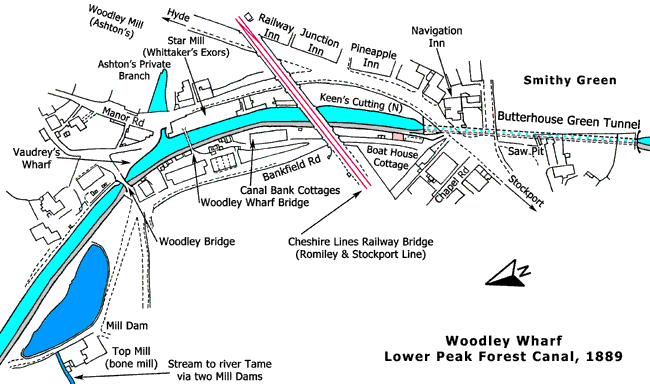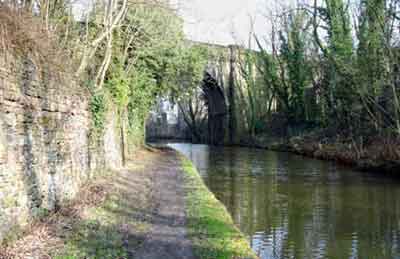
On the approach to Woodley Wharf from the Hyde side, the canal runs onto a short embankment as it approaches the centre of Woodley. Alongside the towpath there was a mill dam for Top Mill, which stood on the far side of the dam, and on the offside there was Black Lane Farm. All these features are no longer extant. The next bridge is the stone-built Woodley Bridge (Bridge 12), which carries Bankfield Road over the canal. In 1841, there were five mills in this locality, three of them were bone mills and the other two were cotton mills. The bone mills were Wood Mill, which was owned by William Vaudrey, while Top Mill and Middle Mill were owned by John Leigh. Wood Mill stood near the river Tame, Middle Mill was a short distance below the canal on Mill Lane and Top Mill also stood on Mill Lane near the canal. Originally, all three mills were water powered, the source of energy being a fast flowing stream that rose near Manor Road and flowed under the canal in a culvert and down to the river Tame. A dam was built by each mill in order to increase the head of water available for the wheel. Ground bone from these mills was in great demand by farmers who used it as a fertiliser on their land. It is understood that fields by the canal were more productive because it was easy to get fertiliser to them by boat. The two cotton mills were Woodley Mill, originally owned by Samuel Ashton, and Star Mill. In addition to these five mills, there was a sixth mill, Bottom Mill, on Mill Lane but more of this below. Confusingly, there were three lanes in this district called 'Mill Lane'.
In 1864 Wood Mill was taken over by John Lees Buckley. The Buckley family, who owned several mills in the vicinity, were major employers during the 19th century and they were keen Methodists and philanthropists. The family came from Oldham but they lived in Stockport for several years before moving to Woodley. Six years later he built Bankfield House close to his mills. It was customary in those days for the master to live nearby if not actually on site. In 1872 he was described as a wool carder and hatter in Worrall's Stockport Directory. There were a hundred men employed at Wood Mill and he also owned Top, Middle and Bottom Mills as well. Between the 1860s and the 1880s he embarked on a programme of rebuilding, as follows:
1864: Wood Mill was rebuilt. 1864: Bottom Mill was rebuilt with four storeys and its name was changed to Botany Mill. This was the largest mill in the group and it is still extant. 1872: Top Mill was rebuilt. 1877: Top Mill was extended. 1883: Middle Mill was rebuilt and became known as Thom Works.
Each mill bore a datestone showing when it was completed. John Lees Buckley died in 1880 but his businesses were continued by two of his sons, Thomas and Samuel.
There were rich seams of coal in the Woodley area and two of the pits were Demesne Pit and Miner Farm Pit. During the 1880s the manager's house and weighing office at Demesne Pit collapsed into the pit shaft and early in the 20th century houses had to be demolished due to subsidence caused by Miner Farm Pit, which was close to the bottom of Mill Lane.
The area immediately beyond Woodley Bridge was known as Woodley Wharf. On the offside, there was the triangular-shaped Vaudrey's Wharf and next to it was the short Ashton's Private Branch for Woodley Mill and a bridge carried Manor Road over this branch. Star Mill, operated by the Exors of Whittaker's, was on the other side of the branch and it had its own wharf. On the towpath side there was Bankfield Terrace and Canal Bank Cottages. It is understood that somewhere along the frontage of Star Mill that there was for a short while a bridge over the canal called Woodley Wharf Bridge. It is not known what type of bridge this was but from its location it is likely that it was a footbridge. It can only have been there for a limited period because it is not listed in the 1888 Distance Tables.

The canal now enters Keen's Cutting, which is about 264-yards long on the north side of Butterhouse Green Tunnel and about 902-yards long on the south side of the tunnel. The contract for Keen's Cutting was awarded to the short-lived partnership of Robert Fulton and Charles McNiven, the latter being an American Engineer. Charles McNiven withdrew from the contract to leave Fulton on his own and then he too withdrew to leave the responsibility to Thomas Brown, the Resident Engineer.
The railway bridge ahead was built by the Cheshire Lines Committee for their Woodley and Stockport Line. Adjoining the portal of Butterhouse Green Tunnel, on the towpath side, there was Boat House Cottage. This was a three-storey building and the ground floor of this was at towpath level so that it could be used to stable boat horses, the floor above for storage and the top floor provided living accommodation for boatmen. Behind the cottage there was a Primitive Methodist Chapel and on the other side of the road stood the Navigation Inn. The village smithy was near the Navigation Inn and this gave its name to Smithy Green. The old name of the area to the west of the tunnel's southern portal was 'Buttresse Green'. At one time it was regarded as a village in its own right and this is how the tunnel got its name.

Cheshire Lines Railway Bridge looking towards Hyde, Feb 2006.
Butterhouse Green Tunnel is 176-yards long and it has a towpath but boats cannot pass inside it. It is the first of the three original tunnels on the Peak Forest Canal, all of which were on the Lower Level. A ramp by the north portal leads up to Hyde Road but there is no access to the road at the south portal.